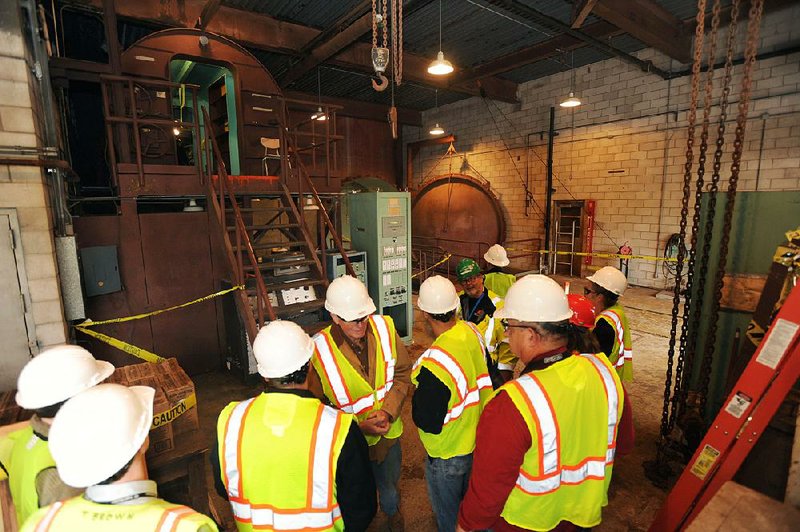STRICKLER -- Deer were plentiful near the nuclear reactor test site. But as a young teenager, Tom Pennel quickly learned from the guards keeping watch what was off-limits.
"They were professional. They were armed, of course," said Pennel, describing himself as one of many hunters herded off the site located about 20 miles southwest of Fayetteville.
Some 40 years later, tour guides rather than armed guards met visitors Thursday at an open house. An estimated 400 people turned out to see inside the operations building for the Southwest Experimental Fast Oxide Reactor on University of Arkansas-owned land near the community of Strickler.
[GALLERY: Photos from SEFOR nuclear reactor tour]
The event provided a rare chance for the public to glimpse a bygone era of nuclear power, with the open house taking place as major cleanup efforts ramp up. UA officials were awarded a $10.5 million grant last year from the U.S. Department of Energy to pay for cleanup, though they say another grant will be needed to restore the site to an empty field with no restrictions on future development.
More people attended than expected, said Mike Johnson, the university's associate vice chancellor for facilities. Pennel, waiting near the beginning of a lengthy line of people, said he came out to satisfy his curiosity.
"I'm back, and I want to see it," Pennel said.
Groups of roughly 20 visitors at a time were let inside to walk along a winding unpaved road toward the operations site. From Arkansas 265, drivers can spot a rusted dome that stands roughly 60 feet above the ground. On Thursday, visitors could see and enter the simple building that once housed the key controls for a working nuclear reactor and a vault structure used to deliver fuel.
The reactor was built in 1968 with funding from the U.S. Atomic Energy Commission, according to UA. From 1969 to 1972, workers successfully operated the 20-megawatt reactor. Operations ceased, however, with UA taking ownership of the site in 1975 to use it for graduate student research. It fell completely out of use by 1986.
UA is working with Salt Lake City-based nuclear services company Energy Solutions. Dean Wheeler, the project manager with Energy Solutions, said the reactor worked but produced only heat as it never was hooked up to any turbine machinery used to produce electricity.
Robert Rosner, a physics professor at the University of Chicago, said in a phone interview that the test reactor, of the type known as a "breeder," was built on the concept of producing plutonium along with energy, with the excess material created by the fission process seen at the time as a way to deal with nuclear waste concerns.
But this raised other worries relating to how plutonium can be used in nuclear weapons, Rosner said.
"In fact, that's how the United States made the plutonium for one of the two atomic bombs dropped on Japan," Rosner said. With such "breeder" reactors, "they were thought to be a real proliferation risk," Rosner said, describing a main reason why the concept fell out of favor in the United States.
He also said that at one time nuclear scientists were unsure about the amount of raw uranium available for use as fuel in nuclear reactors, and this added a bit of appeal to such "breeder" techniques that perhaps could help solve problems related to a lack of fuel materials.
"It turns out uranium reserves are much larger than people thought in the '50s and '60s, so that worry went away," Rosner said, describing uranium availability as only a small factor in decisions made in the era when the Arkansas reactor operated.
Other factors made the Arkansas site stand out, like the use of sodium as a coolant. But Rosner said Navy leadership expressed concerns about this concept, as sodium reacts explosively with water.
Inside the operations building, Wheeler pointed out features designed for safety, like a "rad shower" in place to wash off contamination with a special drain and a 4-foot thick "bioshield" concrete wall. Computer technology was in its infancy at the time reactor operated, so the facility lacked computer screens. A control room, where Wheeler said operators would have spent most of their time, had a series of dials arranged in a circle.
Visitors also saw a mechanical control for a device capable of grabbing and lifting material behind a heavy shield wall.
Wheeler said that fuel was removed from the site after it ceased operations and instrument readings of radiation showed it to be safe inside the operations building.
Part of the cleanup involves further assessment of soil and other materials, he said, and the inner guts of the reactor -- not a part of the tour -- will need to be assessed for radiation and possibly taken to a special site in Utah.
Wheeler said he's worked on the decommissioning of several nuclear reactors, but he's never been involved with a public tour like the one held Thursday. People attending the open house included a group of four UA architecture students documenting their visit -- photography was allowed -- as well as some curious about the site since their youth.
"You worked there, or you didn't go near there," Pennel said -- notwithstanding the occasional adolescent dare, he added.
From Tontitown, about an hour's drive away, Geri Alvis and her husband Gil made the visit.
"They still have the gauges in there, and they remind me of an old sci-fi movie," said Geri Alvis, 62, after completing the tour.
"I'm glad we came, because it was very interesting," she added.
Metro on 01/20/2017
